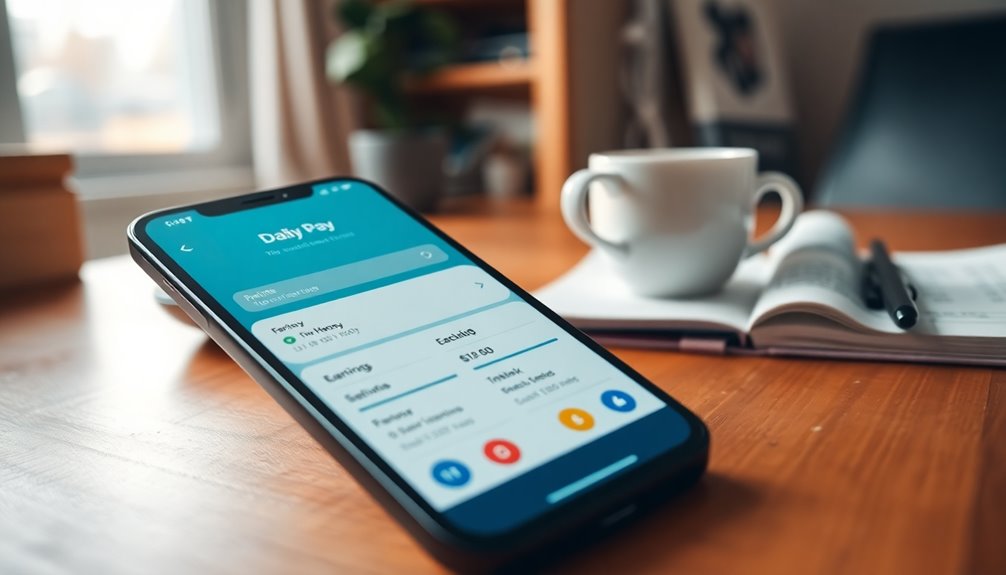Many believe any space used for work qualifies for a home office deduction, but that’s a myth. To claim it, you must use a specific, clearly defined area exclusively for your business on a regular basis. Shared spaces or areas used for personal reasons don’t qualify. Plus, there are limits on what expenses you can deduct. Want to avoid common pitfalls? Keep exploring to learn what’s actually allowed and how to stay compliant.
Key Takeaways
- Only self-employed, contractors, and small business owners can typically claim the deduction; employees generally cannot.
- The space must be used *exclusively and regularly* for business, not for personal or shared purposes.
- Expenses like utilities and mortgage interest are deductible proportionally based on business-use percentage.
- The simplified method caps deductions at $1,500, while actual expenses require detailed documentation and allocation.
- Misconceptions include claiming shared or personal spaces; only dedicated, exclusive-use areas qualify under IRS rules.
Who Qualifies for the Home Office Deduction?

Are you wondering if you qualify for the home office deduction? If you’re self-employed, an independent contractor, or own a small business, you likely do. Gig economy workers using part of their home regularly for business can also qualify. However, employees working remotely for an employer generally can’t claim this deduction under current law. To qualify, your home space must be used *exclusively and regularly* for business, which impacts property valuation and home decor choices. Your home office should serve as your principal place of business or be used for meeting clients. Even a separate structure like a studio or barn used for business purposes can qualify. Remember, personal spaces like guest rooms or kitchens disqualify the deduction, so your home decor must clearly reflect its business use. Additionally, qualification rules remain unchanged from 2024, ensuring consistent eligibility criteria for the upcoming year. Maintaining a dedicated workspace can also support the efficiency of heat pumps, especially in home offices that require a comfortable environment year-round.
Understanding the Exclusive Use Requirement
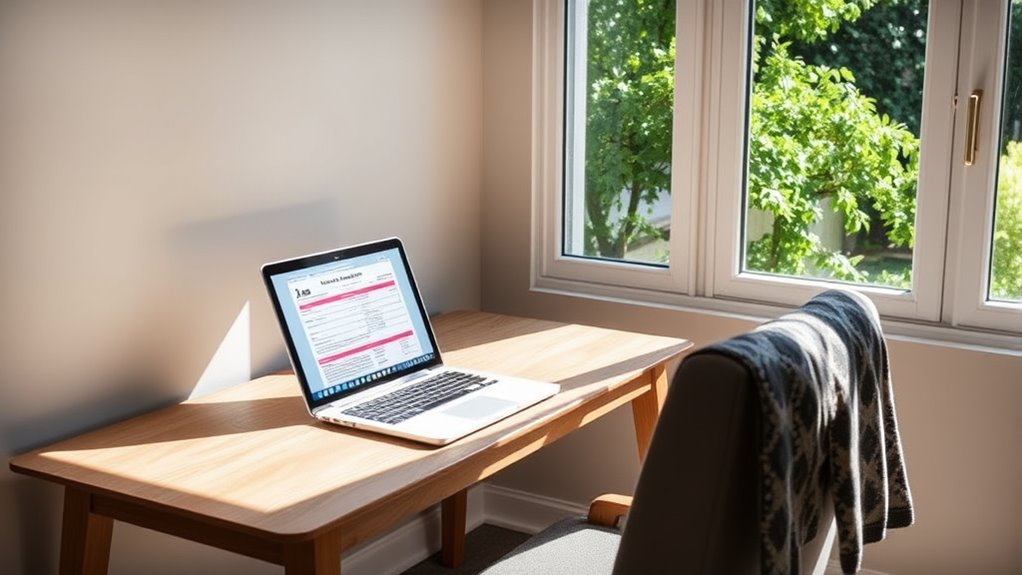
To qualify for the home office deduction, your designated space must be used exclusively for business purposes, meaning it’s dedicated solely to work activities without any personal use. You don’t need room partitions or physical barriers, but the area shouldn’t serve as a shared space for personal activities. A corner of your living room with a dedicated desk can qualify if it’s used only for work, even if you don’t alter the space considerably. Minimal home decor adjustments, like a professional-looking setup, can reinforce its purpose. Occasional personal use, such as a quick phone call or a short visit, generally doesn’t disqualify the space. Remember, violating the exclusive use rule means you can’t claim the deduction, so clarity about your space’s purpose is essential. Understanding my responsibilities about the space helps ensure compliance with the rules.
What Constitutes Regular Business Use?
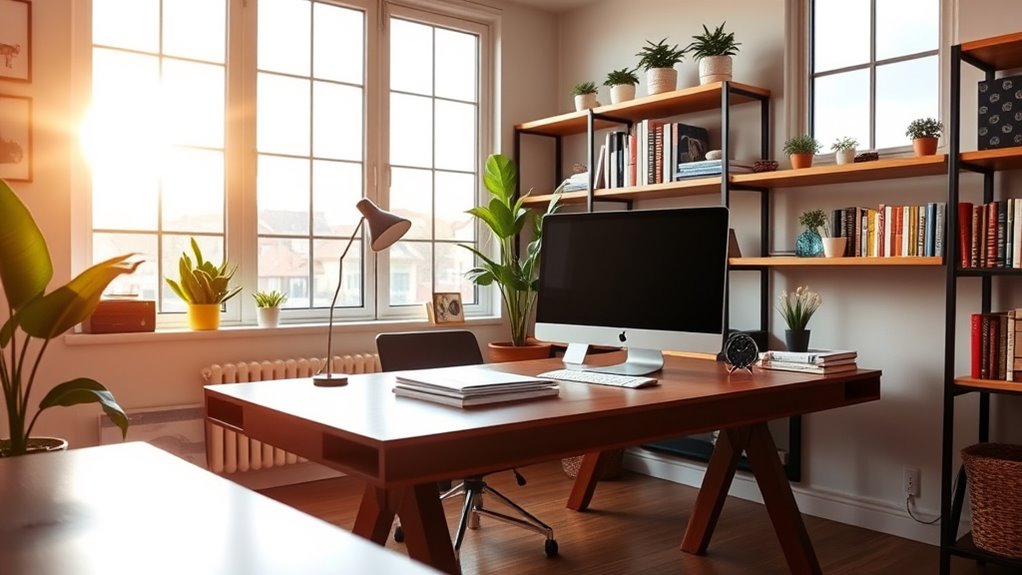
Establishing what counts as regular business use is essential for qualifying for the home office deduction. You need to demonstrate that your space is used consistently for work activities, not just occasionally. Regular use can include working at your desk daily or regularly using your home office furniture for business tasks. It’s also important to keep records of your internet expenses, especially if you use the connection primarily for work. Merely having a space in your home isn’t enough; it must be used regularly and primarily for business purposes. This means your home office should be a dedicated area where you perform work activities consistently, not just a spot where you occasionally check emails. Clear, routine use is key to substantiating your deduction. Understanding the importance of dedicated spaces can help ensure your deduction is properly supported.
Methods to Calculate Your Deduction
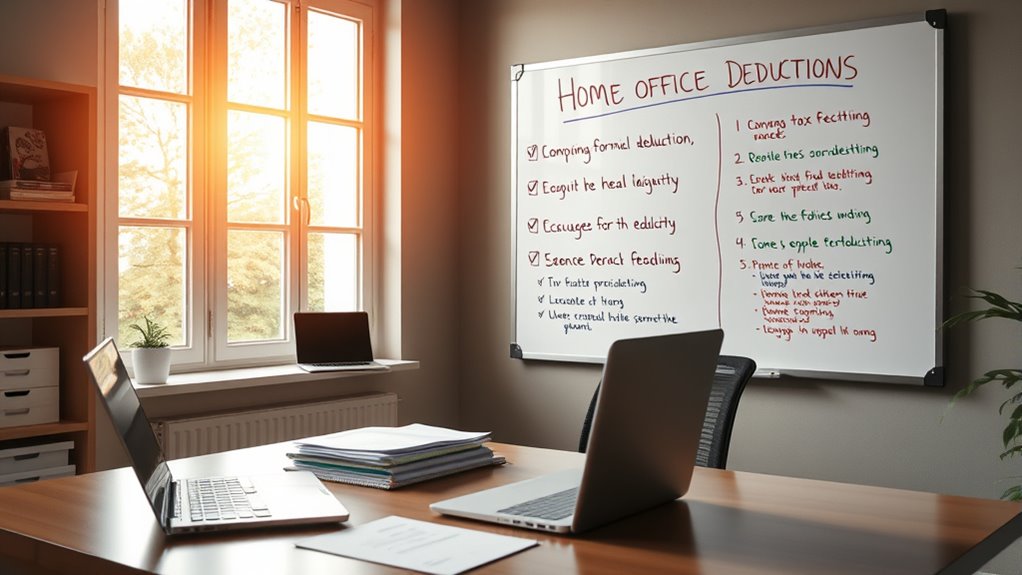
When calculating your home office deduction, you have several methods to choose from, each with its own advantages and requirements. The Actual-Expense Method involves dividing your home into business and personal areas, then allocating expenses like utilities, mortgage interest, and repairs based on the business-use percentage. You deduct the appropriate share of indirect expenses and all direct expenses. The Simplified Method simplifies this process by multiplying the home office square footage (up to 300 sq. ft.) by a set rate of $5 per square foot, with a maximum deduction of $1,500. Ultimately, the Standard Method calculates your deduction by applying the business use percentage to actual home expenses. Each method requires proper expense allocation and documentation to ensure compliance and maximize your home deduction. Understanding projector technology can help you better estimate the value of your home office setup if you incorporate multimedia equipment into your workspace.
How the Tax Cuts and Jobs Act Changed the Rules
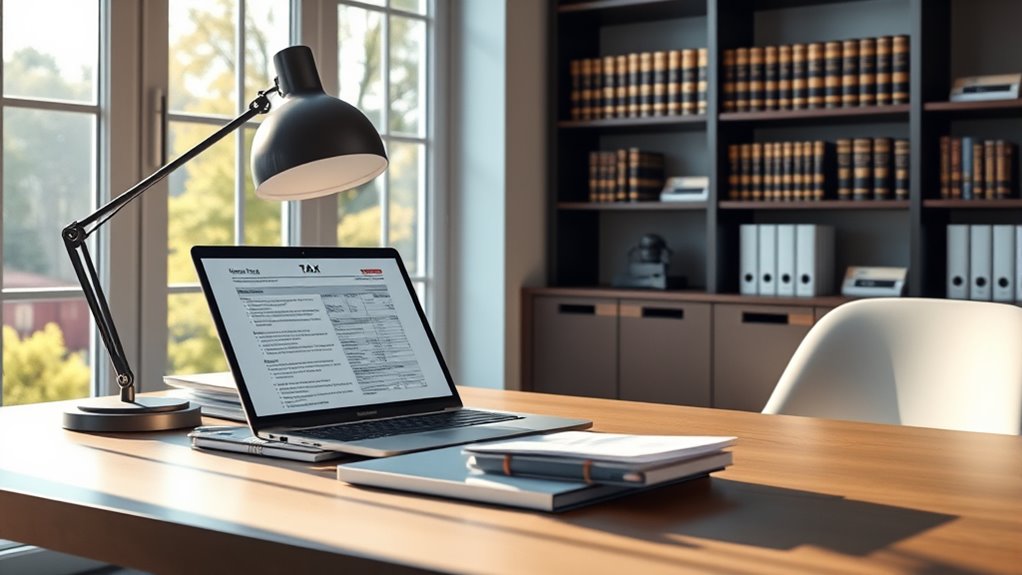
The Tax Cuts and Jobs Act substantially changed home office deduction rules, especially for employees. Now, employee deductions are suspended through 2025, meaning most workers can’t claim home office expenses anymore. However, self-employed individuals and contractors still have clear eligibility criteria they must meet to qualify. Additionally, self-employed taxpayers can continue to deduct home office expenses if they meet the specific requirements, including maintaining adequate records to substantiate their claims.
Employee Deduction Limits
Have you wondered how recent tax law changes affect employee home office deductions? Thanks to the Tax Cuts and Jobs Act, from 2018 to 2025, you can’t deduct home office expenses like home office furniture or internet expenses if you’re an employee. The law suspends miscellaneous itemized deductions subject to the 2% AGI floor, which included these costs. Previously, you could deduct unreimbursed expenses exceeding 2% of your adjusted gross income, but now, unless you’re self-employed, these deductions are off-limits. The change means you can’t claim deductions for supplies or expenses related to working from home, even if your employer doesn’t reimburse you. This limits the tax benefits for employees maintaining a home office during this period. Additionally, the IRS clarifies that employees cannot claim home office deductions during this suspension, regardless of whether they meet the regular and exclusive use criteria for a home office deduction. Moreover, the employee deduction limits have been effectively tightened as a result of the law changes.
Eligibility for Contractors
Since employee home office deductions are largely off the table due to the Tax Cuts and Jobs Act (TCJA), contractors and self-employed individuals can still claim these expenses if they meet certain criteria. The key is maintaining a dedicated home office used exclusively and regularly for business purposes—this dispels common deduction myths. You must keep detailed records, such as expense receipts and usage logs, to substantiate your claim. Eligibility extends to independent contractors, sole proprietors, and freelancers. Remember, your deduction can’t exceed your net business income, and the space must be used solely for work. The TCJA’s impact means employees can’t claim deductions, but contractors still qualify, making understanding these rules essential to maximizing your home office tax benefits. Understanding the specific IRS requirements is crucial to ensure your deduction is legitimate and fully compliant.
Expenses You Can Deduct and Their Limitations

Understanding what expenses qualify and how to prorate them is key to maximizing your home office deduction. You need to know which costs are fully deductible and which require careful calculation based on your space’s percentage. You can also consider cost allocation methods to accurately determine deductible amounts. Remember, there are caps and limitations that can affect how much you can claim, so staying within those boundaries is essential. Additionally, it is important to keep detailed records and receipts to substantiate your claimed expenses should the IRS require verification.
Eligible Deductible Expenses
What expenses qualify as deductible when you use part of your home for business? You can deduct direct expenses, which relate solely to your home office, like repairs or painting in that area. Home improvements that enhance or maintain your designated workspace, such as updating fixtures or painting, are fully deductible. Furniture depreciation for items used exclusively in your office, like desks or chairs, can also be deducted over time. Indirect expenses, like mortgage interest, property taxes, utilities, and homeowner’s insurance, are deductible proportionally based on your workspace percentage. Remember, only expenses that meet the exclusive and regular use criteria qualify. Shared areas or personal spaces aren’t deductible, and proper records are essential to substantiate your claims. Additionally, the IRS requires that your home office be used exclusively for business purposes to qualify for the deduction. Ensuring your home office setup adheres to these guidelines can help maximize your allowable deductions.
Prorating Expenses Correctly
When you prorate expenses for your home office, it’s important to follow the proper rules to guarantee your deductions are accurate and compliant. If you use shared spaces like a living room or kitchen for work, only the portion dedicated exclusively as your office qualifies for proration. For outdoor maintenance, lawn care or exterior repairs are generally not deductible unless they relate directly to your business space. When calculating, use the square footage basis—if 10% of your home is used for work, you can deduct 10% of eligible expenses like utilities, but not for non-deductible items like cleaning or lawn care. Remember, only expenses directly tied to your business use are prorated; personal costs outside your dedicated space don’t qualify. Additionally, understanding deductible expenses can help ensure you maximize your allowable deductions while remaining compliant.
Limitations and Caps
The IRS imposes specific limits on the home office deduction to guarantee you claim only what you’re entitled to. The simplified method caps your deduction at $1,500, regardless of actual expenses, while the actual expense method is limited by the percentage of your home used exclusively for business. The expiration period for these deductions varies, but generally, once the period is exceeded, you can no longer claim them. Personal use areas, like a guest room or playroom, disqualify that space from deduction. Expenses like mortgage interest, property taxes, utilities, and repairs must be prorated according to business use, especially if they involve home renovation. Keep in mind, deductions are also limited to your net business income, and depreciation recapture applies when selling the home. Employees working from home can’t claim this deduction, making understanding these limitations essential to avoid overestimating your potential deduction. Additionally, the deduction cannot exceed the gross income from the business activity conducted in the home.
Common Misconceptions About Home Office Deductions
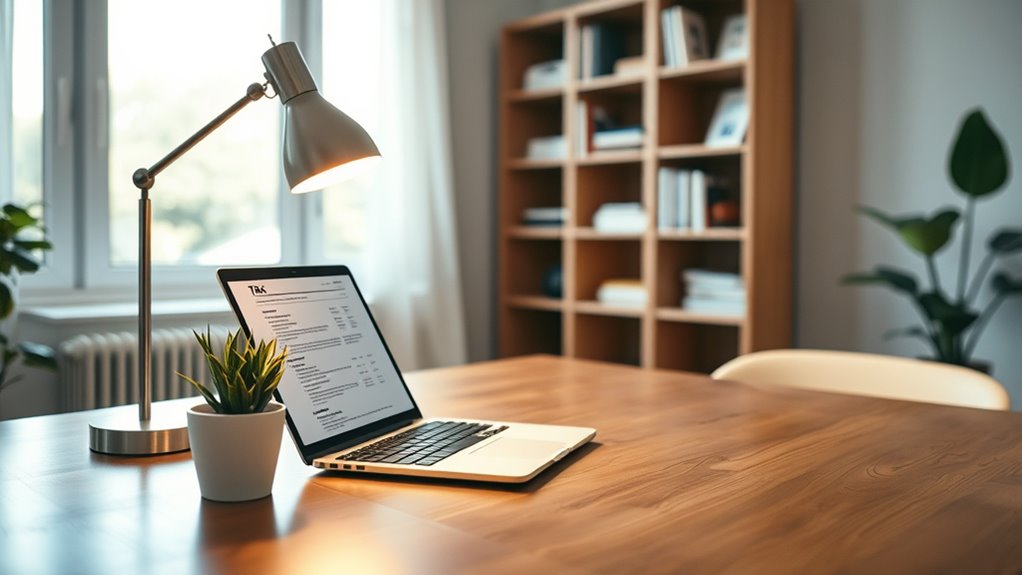
Many people believe they can claim a home office deduction simply because they work from home, but this is a common misconception. To qualify, your space must be used exclusively for business, not for personal activities like watching TV or doing homework. Many assume that sharing a space, like a kitchen table, qualifies, but it doesn’t. Only the part of your home used regularly and as your principal place of business is deductible. This includes expenses like home repair and utility bills, but only for the dedicated workspace. Personal expenses or general household costs, such as a portion of your utility bills, aren’t deductible unless they directly relate to your designated home office. Clear boundaries and documentation are essential to avoid misunderstandings. Strict adherence to IRS rules ensures that the deductions are legitimate and protected during audits.
Tips for Proper Documentation and Compliance
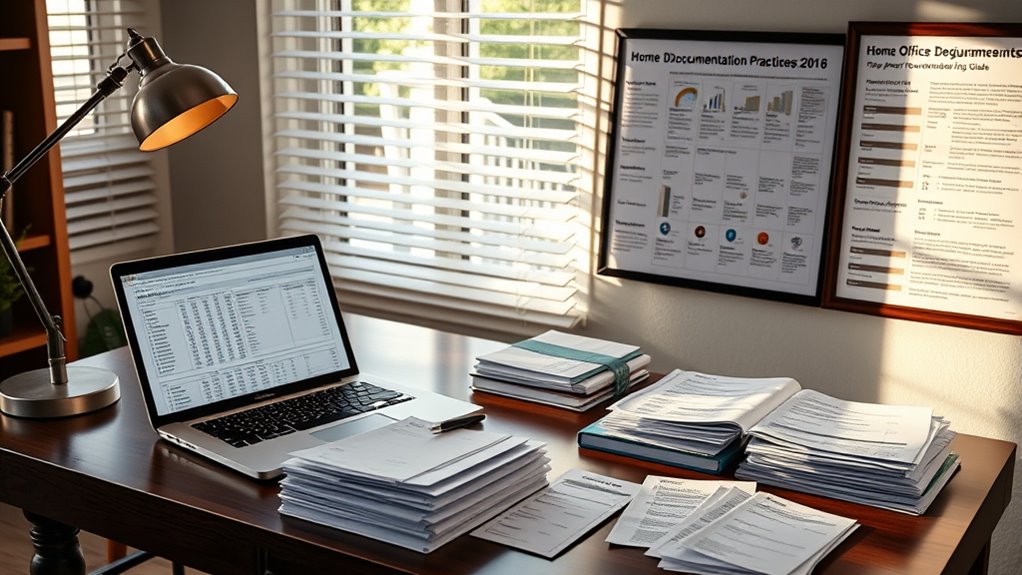
Accurate documentation is essential to demonstrate your home office qualifies for deductions and to guarantee compliance with IRS rules. You should keep detailed records of your home office space, including photos and a clear floor plan, showing exclusive and regular use. Track expenses related to home office furniture and storage solutions separately from personal items. Maintain logs of business activities, client meetings, and time spent working in the designated area, along with receipts for utilities, repairs, and improvements. Use spreadsheets or accounting software to allocate expenses proportionally. Here’s a quick overview:
| Documentation Type | Key Details |
|---|---|
| Space & Use Evidence | Photos, floor plans, activity logs |
| Expense & Meeting Records | Receipts, invoices, meeting logs |
| Compliance & Method Tracking | Method choice, square footage, depreciation info |
Frequently Asked Questions
Can Employees Claim a Home Office Deduction Under Current Tax Law?
Under current tax law, employees can’t claim a home office deduction. If you’re a freelancer or independent contractor, you might be able to deduct expenses like a dedicated workspace, including rental property costs. But if you’re a regular employee, you’re out of luck. Remember, only self-employed individuals or those with rental property used exclusively for business can claim these deductions, and proper documentation is essential.
Is a Shared Space, Like a Living Room Corner, Eligible for the Deduction?
Shared spaces like a living room corner typically aren’t eligible for the home office deduction because casual areas are usually used for personal activities. To qualify, you must use the space exclusively and regularly for business, and overlapping with casual or personal use disqualifies it. If you can clearly separate and allocate part of the shared space solely for your business, then you might meet the IRS requirements.
How Does Using a Garage or Shed for Work Affect Eligibility?
Using a garage workspace or shed workspace can qualify for a home office deduction if you meet IRS rules. Your garage or shed must be a separate, unattached structure used exclusively and regularly for business. If you store inventory, the space can be used for mixed purposes. Keep the workspace identifiable and avoid personal use to maintain eligibility, and you can choose between simplified or regular deduction methods.
Are There Specific Record-Keeping Requirements for the Deduction?
You need to understand the record keeping requirements for the home office deduction. Keep thorough documentation standards, including proof of exclusive and regular use, such as floor plans, photos, and logs. Save receipts for expenses like utilities and repairs. Maintain these records for as long as needed, typically at least four years, to substantiate your claims. Proper record keeping minimizes audit risks and ensures compliance with IRS rules.
Does the Deduction Apply if My Home Office Is Used for Storage Only?
Imagine a dedicated warehouse in your home, filled with inventory, with no desks or offices. If your space is used for storage only, you might wonder if you can claim a deduction. The IRS allows this if your storage is a separate, identifiable area used regularly for inventory or samples, even with incidental use for personal items. So, yes, a storage-only space can qualify, provided it meets the rules.
Conclusion
Exploring the home office deduction is like threading the needle of a labyrinth—complex yet rewarding when done right. By understanding the rules, avoiding misconceptions, and keeping meticulous records, you guarantee your claim stays above reproach. Remember, even Icarus’s ascent depended on careful planning; so too, your deduction’s success hinges on compliance. Stay informed, stay diligent, and let the myth of the “easy deduction” give way to your well-earned, legitimate savings.


